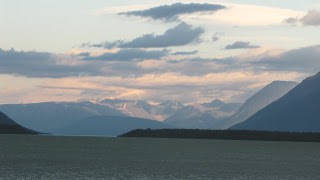Some of you may already be aware that a float plane with the pilot and 3 Katmai National Park maintenance department employees has been lost since this past Saturday. We are all saddened by this turn of events, particularly in light of the loss due to presumed drowning last month of a German visitor who was hiking with 4 friends in the Valley of 10,000 Smokes. His body has not been recovered from the River Lethe which bisects the Valley. Many of the park rangers had talked with this fellow and his friends over the course of their stay at the park. I had encouraged them to buy the USGS topographic maps of the hike area and not just rely on the less-detailed Trails Illustrated map of Katmai. He and his friends came to my evening program. Alaska senator Ted Stevens also recently died in a plane crash just outside the boundary of Katmai.
Concerning the park employees, I do not know Neal or Mason very well but whenever our paths crossed they were very friendly. Mason always had a friendly hello; his parents were here this summer for a visit. I do not know Neal’s brother nor do I know the pilot of the aircraft. Neal helped me out once with some sketchy tire inflation on the Park vehicle I was about to take out to the Valley. I was told that if there was anyone who could survive a plane going down, it was Neal. He apparently could build a cabin out of twigs and moss and train a moose to help him out. I believe there would have been survival supplies on the plane, but I can’t verify this for certain.
This sad event has given me much to think about in terms of my own readiness in case of some emergency. I joked in my last post about being “overprepared” for our backpack trip into the Valley, but that really only referred to our wanting to take wine and diet coke with us. But what about it? How prepared would I really have been if it were my plane that had gone down? Could I survive? And if I could, for how long? What sort of back-country skills do I possess that would enable me to survive in the Alaskan bush – or even my own backyard of the canyon country of southern Utah?
Would I have really been paying attention when the pilot explained where the fire extinguisher or emergency locator transmitter (ELT) was, and how to operate them? Would I have been paying attention to landmarks on the ground, or just taken it for granted that the pilot knew 100% what he or she was doing? Would I have had any personal survival gear on me, if only some extra food, rain gear, a set of water-proof matches and a flashlight with extra batteries? There apparently are no radio or ELT signals being received from the plane. Were the batteries low? How could we know this if we hadn’t personally checked them?
When we took that “dunker training” during orientation, we were simulating a plane going down in a body of water – I felt afterward that I at least had a fighting chance of surviving an impact, even though the exercise had taken place in the warm waters of the Naknek city pool. My first thought during the training was what to do with my glasses – without them I’d be helpless.
It all makes me realize that I must take responsibility for my own survival more seriously, and not be blasé about letting things slide, thinking they’ll be all right because they always have been – so far. I have come to Alaska for the summer, and my time here has almost come to an end – but how prepared am I, really, for any eventuality?
The search area is vast. It is Alaska, after all. The many people working with Search-And-Rescue are to be commended for their dedication and professionalism. My heart goes out to the families.







